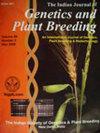GGE biplot analysis for identification of ideal cultivars and testing locations of pearl millet (Pennisetum glaucum L.R. Br.) for peninsular India
IF 0.8
4区 生物学
Q3 PLANT SCIENCES
引用次数: 1
Abstract
Pearl millet is a climate resilient crop grown by resource poor farmers. Identification of the ideal genotypes for broad and specific adaptation and ideal locations for testing in peninsular India (classified as B-zone) will address the needs of farmers and researchers working in this region. In the present study, performance of eight hybrids and four varieties over seven locations across three rainy seasons (2017-2019) was investigated using GGE biplot analysis. Location attributed higher proportion (59.3–89.9%) of the variation for eight traits, while genotype and genotype×environment interaction accounted for 57 to 65% of total variability for grain and dry fodder yields. The hybrids 86M86, KSB and NBH5061 are identified as ideal genotypes for cultivation across B-zone. Majority of the testing locations were highly correlated with Vijayapura, which is most discriminative and representative location. ‘Which-won where’ study partitioned the testing locations into two mega-environments: first with four locations with 86M01 as winning genotype and second encompassed three locations with KSB as the winning genotype. The Vijayapura, Ananthapuram and Dhule locations were identified for initial testing of genotypes. Hybrid advantage over varieties for grain and fodder yields was clearly observed from the study.印度半岛珍珠粟(Pennisetum glaucum l.r.br .)理想品种和试验地点的GGE双标图分析
珍珠粟是资源贫乏的农民种植的一种适应气候变化的作物。在印度半岛(分类为b区)确定广泛和特定适应的理想基因型和理想的测试地点将满足在该地区工作的农民和研究人员的需求。本研究采用GGE双标图分析方法,研究了2017-2019年3个雨季,8个杂交种和4个品种在7个地点的表现。位置对8个性状的变异贡献率较高(59.3 ~ 89.9%),而基因型和genotype×environment互作对谷物和干饲料产量的总变异贡献率为57 ~ 65%。杂种86M86、KSB和NBH5061被确定为跨b区栽培的理想基因型。大多数测试地点与Vijayapura高度相关,这是最具歧视性和代表性的地点。“谁赢了谁”的研究将测试地点分为两个大环境:第一个有四个地点,86M01为获胜基因型,第二个包括三个地点,KSB为获胜基因型。对Vijayapura、Ananthapuram和Dhule地点进行了初步基因型检测。在粮食和饲料产量方面,杂交优势明显高于品种。
本文章由计算机程序翻译,如有差异,请以英文原文为准。
求助全文
约1分钟内获得全文
求助全文
来源期刊

Indian Journal of Genetics and Plant Breeding
PLANT SCIENCES-
CiteScore
1.80
自引率
10.00%
发文量
0
审稿时长
6-12 weeks
期刊介绍:
Advance the cause of genetics and plant breeding and to encourage and promote study and research in these disciplines in the service of agriculture; to disseminate the knowledge of genetics and plant breeding; provide facilities for association and conference among students of genetics and plant breeding and for encouragement of close relationship between them and those in the related sciences; advocate policies in the interest of the nation in the field of genetics and plant breeding, and facilitate international cooperation in the field of genetics and plant breeding.
 求助内容:
求助内容: 应助结果提醒方式:
应助结果提醒方式:


